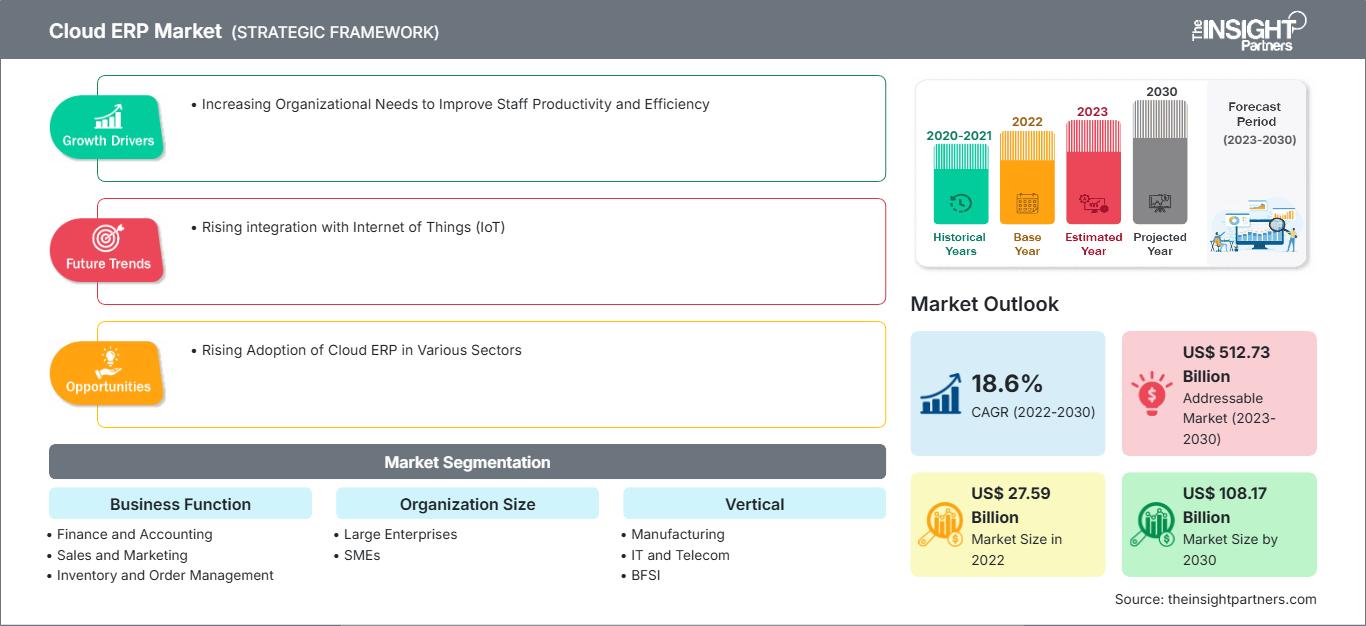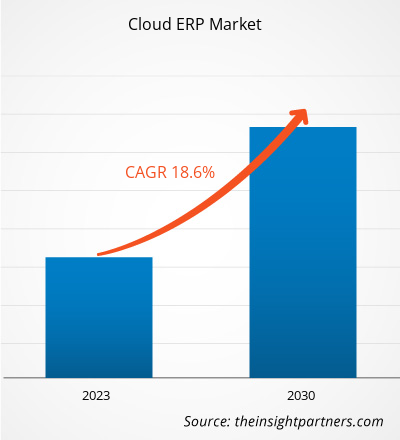クラウドERP市場は、2022年の275億9000万米ドルから2030年には1081億7000万米ドルに成長すると予想されており、2022年から2030年にかけて18.6%の年平均成長率(CAGR)を記録すると推定されています。モノのインターネット(IoT)との統合の増加は、今後も市場の重要なトレンドであり続けるでしょう。
クラウドERP市場分析
様々な企業が新しいクラウドベースのERPソフトウェアをリリースしています。例えば、2023年6月には、10X ERPがクラウドベースのERPソフトウェアのリリースを発表しました。このソフトウェアは、中小規模の産業流通事業のニーズに応えるために特別に設計されています。このソリューションは、直感的で使いやすく、高速なエクスペリエンスを提供します。中核機能には、販売注文および注文書の入力、在庫管理、顧客およびベンダー関係管理、リアルタイムダッシュボード、カスタム出荷インテグレーター、品質管理ツール、リアルタイムデータを提供する堅牢で完全に統合された会計システムなど、幅広い機能が含まれています。市場プレーヤーによるこのような取り組みは、市場におけるクラウド ERPの成長を促しています。さらに、製造、ITおよび通信、BFSI、ヘルスケア、小売など、さまざまな業界の垂直市場でクラウド ERPソフトウェアの採用が増えていることも、市場の成長を促しています。さらに、ソフトウェアの技術進歩の進展も、クラウド ERP市場の成長をさらに促進すると予想されています。
クラウド ERP 市場の概要
クラウド ERPは、インターネット経由でアクセスできるエンタープライズリソースプランニングソフトウェアとして知られています。プロバイダーのクラウドコンピューティングプラットフォームでホストされるクラウド ERPは、通常、サービスとして提供されます(サービスとしてのソフトウェア、またはSaaS ERP)。クラウド ERPソフトウェアにはさまざまな利点があります。クラウドERPソフトウェアの最大のメリットの一つは、ほぼ無限のカスタマイズ性です。アドオンソリューション、オープンAPI、業界固有の機能、そしてロールベースのダッシュボードにより、企業は強力な意思決定ツール、比類のないデータ可視性、そして将来を見据えた成功のためのプラットフォームを実装できます。企業は、流通、製造、小売、建設など、それぞれの業界のニーズに合わせて設計されたエディションを選択できます。現場チームとオフィスチームは、複数のプロジェクトを予算内で期限内に完了するために連携して作業しますが、効率的な情報がないと課題が生じます。建設業界に特化したERPソフトウェアは、財務、原価計算、在庫、CRM、給与計算、プロジェクト管理など、さまざまなアプリケーションとシステムを統合し、チーム内のすべての従業員を瞬時に結びつけ、ビジネスの完全なリアルタイムビューを提供します。
要件に合わせてレポートをカスタマイズ
レポートの一部、国レベルの分析、Excelデータパックなどを含め、スタートアップ&大学向けに特別オファーや割引もご利用いただけます(無償)
クラウドERP市場: 戦略的洞察

-
このレポートの主要な市場動向を入手してください。この無料サンプルには、市場動向から見積もりや予測に至るまでのデータ分析が含まれます。
クラウドERP市場の推進要因と機会
従業員の生産性と効率性の向上による市場優位性への組織的ニーズの高まり
企業は、現在の急速に変化する競争の激しい商業環境において、生産性と効率性を向上させる方法を常に模索しています。クラウドベースのエンタープライズ・リソース・プランニング(ERP)システムは、ビジネスの成長、コラボレーション、そして効率的な業務運営を支援するため、大きな注目を集めています。クラウドERPは、従来のオンプレミスシステムに比べて様々なメリットを提供します。クラウドベースのシステムは、インターネット接続があればどこからでもアクセスできます。つまり、従業員は重要なビジネスコラボレーションデータを取得し、リモートでタスクを実行できます。例えば、営業担当者は外出先からリアルタイムの在庫データにアクセスできるため、タイムリーな顧客対応が可能になります。クラウドERPはリアルタイムのデータ更新と分析を提供し、情報に基づいた意思決定に活用できます。例えば、クラウドERPシステムから取得したデータを使用することで、管理者は在庫レベルと需要をリアルタイムで監視し、積極的な補充や生産スケジュールの最適化が可能になります。クラウド ERP には、チームワークと調整を改善するコラボレーション ツールが含まれています。たとえば、クラウド ERP システムは、プロジェクト管理と遠隔地のチーム間のコラボレーションを促進し、プロジェクト ワークフローを合理化し、エラーを削減します。さらに、クラウド ERP は、プロセスを自動化し、オンプレミス インフラストラクチャの必要性を減らすことで運用コストを削減できます。
さまざまな分野でのクラウド ERP の採用増加
クラウド ERP 市場はここ数年で力強く成長しており、その主な推進要因の 1 つはクラウド ERP システムのデジタル化です。高度なテクノロジーと、合理化され効果的な税務プロセスを求める企業からの需要の高まりにより、税務に関連するすべての活動を容易にするデジタル ソリューションの需要が急上昇しています。クラウド ERP システムのデジタル化は、あらゆる規模の企業や個人に多くのメリットをもたらします。大きな利点の 1 つは、税務に関連するすべてのタスクの自動化です。これにより手作業が削減され、エラーの可能性が最小限に抑えられます。クラウド ERP を使用すると、データ入力、税金の計算、レポートを自動化できるため、正確性と税法の遵守が確保されます。
クラウド ERP 市場レポートのセグメンテーション分析
クラウド ERP 市場分析の導出に貢献した主要なセグメントは、ビジネス機能、組織規模、垂直です。
- ビジネス機能に基づいて、市場は財務および会計、販売およびマーケティング、在庫および注文管理、人的資本管理、その他に分割されています。 在庫および注文管理セグメントは 2022 年に市場を支配しました。
- 組織規模に基づいて、市場は大企業と中小企業に二分されています。 大企業セグメントは 2022 年に市場を支配しました。
- 垂直に基づいて、商業企業市場は製造、IT および通信、BFSI、ヘルスケア、小売、政府、航空宇宙および防衛、その他に二分されています。 2022年には製造業が市場を支配しました。
クラウド ERP 市場シェアの地域別分析
クラウド ERP 市場レポートの地理的範囲は、主に北米、アジア太平洋、ヨーロッパ、中東およびアフリカ、南米および中米の5つの地域に分かれています。
2022年には北米が市場を支配しました。技術の変化は北米経済に大きな影響を与えています。北米のすべての先進国は、技術革新の創出に重点を置いています。米国経済はテクノロジーに大きく依存しています。その結果、多くの州がイノベーションを刺激し、起業家を支援するための主要な取り組みを開始しています。最も頻繁に言及されるテクノロジーは、モノのインターネット (IoT)、ビッグデータ分析、モビリティ、人工知能 (AI)、デジタルメディア、バイオテクノロジー、遠隔医療、クラウドコンピューティングです。北米のさまざまな企業が新しいクラウドベースのソフトウェアを導入しています。例えば、SAP SEは2023年4月、グレーター・オースティン商人協同組合(GAMA)が組織の将来を見据えたビジネス変革を支援するために、パブリックエディションであるSAP S/4HANA Cloudを選定したことを発表しました。SAP S/4HANA Cloudのパブリックエディションにより、SAPは業界のベストプラクティスを組み込んだクラウドERPの実証済みのメリットを中堅企業が活用できるよう支援しています。
CloudERP
クラウド ERP 市場の地域別分析
The Insight Partnersのアナリストは、予測期間を通じてクラウドERP市場に影響を与える地域的なトレンドと要因を詳細に解説しています。このセクションでは、北米、ヨーロッパ、アジア太平洋、中東・アフリカ、中南米におけるクラウドERP市場のセグメントと地域についても解説しています。
クラウド ERP 市場レポートの範囲
| レポート属性 | 詳細 |
|---|---|
| の市場規模 2022 | US$ 27.59 Billion |
| 市場規模別 2030 | US$ 108.17 Billion |
| 世界的なCAGR (2022 - 2030) | 18.6% |
| 過去データ | 2020-2021 |
| 予測期間 | 2023-2030 |
| 対象セグメント |
By ビジネス機能
|
| 対象地域と国 |
北米
|
| 市場リーダーと主要企業の概要 |
|
クラウド ERP 市場のプレーヤー密度:ビジネスダイナミクスへの影響を理解する
クラウドERP市場は、消費者の嗜好の変化、技術の進歩、製品メリットへの認知度の高まりといった要因によるエンドユーザー需要の高まりに牽引され、急速に成長しています。需要が高まるにつれ、企業は提供内容を拡大し、消費者ニーズを満たすためのイノベーションを推進し、新たなトレンドを捉えることで、市場の成長をさらに加速させています。

- 入手 クラウドERP市場 主要プレーヤーの概要
クラウド ERP 市場のニュースと最近の動向
クラウド ERP 市場は、主要な企業出版物、協会データ、データベースなどの一次調査と二次調査後の定性的および定量的データを収集することで評価されます。クラウド ERP 市場の動向のいくつかを以下に示します。
- SAP とそのパートナーである SGN Software Pvt Ltd は、中小企業向けに設計された主力のクラウド ERP 製品を開始しました。(出典: SAP、プレスリリース、2024 年 7 月)
- 産業中規模市場向け ERP ソフトウェア ソリューションのヨーロッパのプロバイダーである Forterro は、エントリーレベルのクラウドベース ERP ソリューションである Fortee の英国での発売を発表しました。Fortee は、中小企業のディスクリート製造業者と産業の新興企業のニーズに合わせて特別に設計されており、15 年にわたるクラウド ERP の学習に基づいています。 (出典: Forterro、プレスリリース、2024 年 5 月)
クラウド ERP 市場レポートの対象範囲と成果物
「クラウド ERP 市場の規模と予測 (2020~2030 年)」このレポートでは、以下の分野を網羅した市場の詳細な分析を提供しています。
- 調査対象となるすべての主要市場セグメントの世界、地域、国レベルでのクラウド ERP 市場規模と予測
- クラウド ERP 市場の動向、推進要因、制約、主要な機会などの市場動向
- 詳細な PEST/ポーターの 5 つの力と SWOT 分析
- 主要な市場動向、世界および地域のフレームワーク、主要プレーヤー、規制、最近の市場動向を網羅したクラウド ERP 市場分析
- 市場集中、ヒートマップ分析、主要プレーヤー、超伝導市場の最近の動向を網羅した業界の状況と競争分析
- 詳細な企業プロファイル
- 過去2年間の分析、基準年、CAGRによる予測(7年間)
- PEST分析とSWOT分析
- 市場規模価値/数量 - 世界、地域、国
- 業界と競争環境
- Excel データセット
最新レポート
お客様の声
購入理由
- 情報に基づいた意思決定
- 市場動向の理解
- 競合分析
- 顧客インサイト
- 市場予測
- リスク軽減
- 戦略計画
- 投資の正当性
- 新興市場の特定
- マーケティング戦略の強化
- 業務効率の向上
- 規制動向への対応






















 無料サンプルを入手 - クラウドERP市場
無料サンプルを入手 - クラウドERP市場